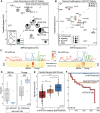This is a preprint.
Identification and targeting of treatment resistant progenitor populations in T-cell Acute Lymphoblastic Leukemia
- PMID: 37961674
- PMCID: PMC10635362
- DOI: 10.21203/rs.3.rs-3487715/v1
Identification and targeting of treatment resistant progenitor populations in T-cell Acute Lymphoblastic Leukemia
Abstract
Refractoriness to initial chemotherapy and relapse after remission are the main obstacles to cure in T-cell Acute Lymphoblastic Leukemia (T-ALL). Biomarker guided risk stratification and targeted therapy have the potential to improve outcomes in high-risk T-ALL; however, cellular and genetic factors contributing to treatment resistance remain unknown. Previous bulk genomic studies in T-ALL have implicated tumor heterogeneity as an unexplored mechanism for treatment failure. To link tumor subpopulations with clinical outcome, we created an atlas of healthy pediatric hematopoiesis and applied single-cell multiomic (CITE-seq/snATAC-seq) analysis to a cohort of 40 cases of T-ALL treated on the Children's Oncology Group AALL0434 clinical trial. The cohort was carefully selected to capture the immunophenotypic diversity of T-ALL, with early T-cell precursor (ETP) and Near/Non-ETP subtypes represented, as well as enriched with both relapsed and treatment refractory cases. Integrated analyses of T-ALL blasts and normal T-cell precursors identified a bone-marrow progenitor-like (BMP-like) leukemia sub-population associated with treatment failure and poor overall survival. The single-cell-derived molecular signature of BMP-like blasts predicted poor outcome across multiple subtypes of T-ALL within two independent patient cohorts using bulk RNA-sequencing data from over 1300 patients. We defined the mutational landscape of BMP-like T-ALL, finding that NOTCH1 mutations additively drive T-ALL blasts away from the BMP-like state. We transcriptionally matched BMP-like blasts to early thymic seeding progenitors that have low NR3C1 expression and high stem cell gene expression, corresponding to a corticosteroid and conventional cytotoxic resistant phenotype we observed in ex vivo drug screening. To identify novel targets for BMP-like blasts, we performed in silico and in vitro drug screening against the BMP-like signature and prioritized BMP-like overexpressed cell-surface (CD44, ITGA4, LGALS1) and intracellular proteins (BCL-2, MCL-1, BTK, NF-κB) as candidates for precision targeted therapy. We established patient derived xenograft models of BMP-high and BMP-low leukemias, which revealed vulnerability of BMP-like blasts to apoptosis-inducing agents, TEC-kinase inhibitors, and proteasome inhibitors. Our study establishes the first multi-omic signatures for rapid risk-stratification and targeted treatment of high-risk T-ALL.
Conflict of interest statement
Competing interest: DTT received research funding from BEAM Therapeutics, NeoImmune Tech and serves on advisory boards for BEAM Therapeutics, Janssen, Servier, Sobi, and Jazz. DTT has multiple patents pending on CAR-T. The remaining authors declare that they have no competing interest.
Figures





Similar articles
-
Single-cell RNA sequencing distinctly characterizes the wide heterogeneity in pediatric mixed phenotype acute leukemia.Genome Med. 2023 Oct 16;15(1):83. doi: 10.1186/s13073-023-01241-z. Genome Med. 2023. PMID: 37845689 Free PMC article.
-
Blast cells surviving acute myeloid leukemia induction therapy are in cycle with a signature of FOXM1 activity.BMC Cancer. 2021 Oct 28;21(1):1153. doi: 10.1186/s12885-021-08839-9. BMC Cancer. 2021. PMID: 34711181 Free PMC article.
-
Early Response-Based Therapy Stratification Improves Survival in Adult Early Thymic Precursor Acute Lymphoblastic Leukemia: A Group for Research on Adult Acute Lymphoblastic Leukemia Study.J Clin Oncol. 2017 Aug 10;35(23):2683-2691. doi: 10.1200/JCO.2016.71.8585. Epub 2017 Jun 12. J Clin Oncol. 2017. PMID: 28605290 Clinical Trial.
-
[Therapeutic strategies for childhood high-risk acute lymphoblastic leukemia].Beijing Da Xue Xue Bao Yi Xue Ban. 2013 Apr 18;45(2):327-32. Beijing Da Xue Xue Bao Yi Xue Ban. 2013. PMID: 23591360 Review. Chinese.
-
New insights into Notch1 regulation of the PI3K-AKT-mTOR1 signaling axis: targeted therapy of γ-secretase inhibitor resistant T-cell acute lymphoblastic leukemia.Cell Signal. 2014 Jan;26(1):149-61. doi: 10.1016/j.cellsig.2013.09.021. Epub 2013 Oct 16. Cell Signal. 2014. PMID: 24140475 Review.
References
-
- Hunger S. P. & Mullighan C. G. Acute Lymphoblastic Leukemia in Children. N. Engl. J. Med. 373, 1541–1552 (2015). - PubMed
-
- Wood B. L. et al. T-Lymphoblastic Leukemia (T-ALL) Shows Excellent Outcome, Lack of Significance of the Early Thymic Precursor (ETP) Immunophenotype, and Validation of the Prognostic Value of End-Induction Minimal Residual Disease (MRD) in Children’s Oncology Group (COG) Study AALL0434. Blood 124, 1–1 (2014). - PubMed
Publication types
Grants and funding
LinkOut - more resources
Full Text Sources
Research Materials
Miscellaneous

